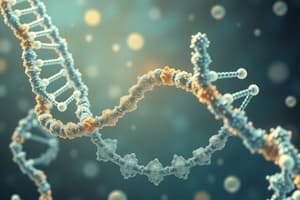Podcast
Questions and Answers
What is the monomer of nucleic acids?
What is the monomer of nucleic acids?
A nucleotide
Describe the structure of a nucleotide.
Describe the structure of a nucleotide.
- A phosphate group, 2. 5 carbon sugar, 3. Nitrogenous base.
How does a nucleoside differ from a nucleotide?
How does a nucleoside differ from a nucleotide?
A nucleoside is a nucleotide without the phosphate group.
What are purines and pyrimidines?
What are purines and pyrimidines?
What is the difference between ribose and deoxyribose?
What is the difference between ribose and deoxyribose?
Describe the polymerization of nucleotides.
Describe the polymerization of nucleotides.
Name the two types of nucleic acids.
Name the two types of nucleic acids.
What is the primary structure of nucleic acids?
What is the primary structure of nucleic acids?
What is the primary structure of DNA?
What is the primary structure of DNA?
What is the secondary structure of DNA?
What is the secondary structure of DNA?
What is the law of base pairing?
What is the law of base pairing?
What are the steps of DNA replication?
What are the steps of DNA replication?
What is the difference between DNA and RNA?
What is the difference between DNA and RNA?
What is the secondary structure of RNA?
What is the secondary structure of RNA?
What is the tertiary structure of RNA?
What is the tertiary structure of RNA?
Why does RNA have catalytic functions and DNA does not?
Why does RNA have catalytic functions and DNA does not?
What is the significance of the 2' 3' and 5' carbon on a sugar?
What is the significance of the 2' 3' and 5' carbon on a sugar?
Flashcards are hidden until you start studying
Study Notes
Nucleic Acids Overview
- The basic unit of nucleic acids is a nucleotide.
- Nucleotides consist of a phosphate group, a 5-carbon sugar, and a nitrogenous base.
Nucleosides vs Nucleotides
- A nucleoside lacks the phosphate group found in nucleotides.
Purines vs Pyrimidines
- Purines have a two-ring structure and include adenine and guanine.
- Pyrimidines have a single-ring structure and include cytosine, uracil, and thymine.
Ribose and Deoxyribose
- Ribose contains an oxygen atom at the 2' carbon, while deoxyribose has only a hydrogen atom at this position.
Polymerization of Nucleotides
- Nucleotides polymerize through dehydration synthesis, forming phosphodiester bonds between the phosphate group of one nucleotide and the hydroxyl group on the 3' carbon of another.
Types of Nucleic Acids
- Ribonucleic acid (RNA) is formed from ribonucleotides.
- Deoxyribonucleic acid (DNA) is formed from deoxyribonucleotides.
Primary Structure of Nucleic Acids
- The primary structure is represented by the sequence of nucleotides in a strand, oriented from 5' to 3'.
Secondary Structure of DNA
- DNA forms a double helix with two antiparallel strands stabilized by hydrogen bonds between complementary base pairs: A-T and G-C.
Law of Base Pairing
- Specific base pairing rules dictate that adenine pairs with thymine in DNA (or uracil in RNA) and guanine pairs with cytosine.
DNA Replication Steps
- Copies of DNA are made through several steps, including the unwinding of the double helix, base pairing of free deoxyribonucleotides with the template strand, and formation of new daughter strands.
DNA vs RNA
- Both DNA and RNA serve as information-carrying molecules; RNA is single-stranded, while DNA is double-stranded.
Secondary Structure of RNA
- RNA can form secondary structures by folding back on itself and creating hydrogen bonds with complementary bases within the same strand.
Tertiary Structure of RNA
- The tertiary structure results from further folding of the secondary structure into complex three-dimensional shapes.
Catalytic Functions of RNA
- RNA possesses catalytic functions due to its reactive functional groups on the accessible single strand, unlike DNA where functional groups are protected between the strands.
Significance of Sugar Carbons
- The 2' carbon distinguishes between ribose and deoxyribose.
- The 3' and 5' carbons are essential for the polymerization process in nucleic acid formation.
Studying That Suits You
Use AI to generate personalized quizzes and flashcards to suit your learning preferences.



